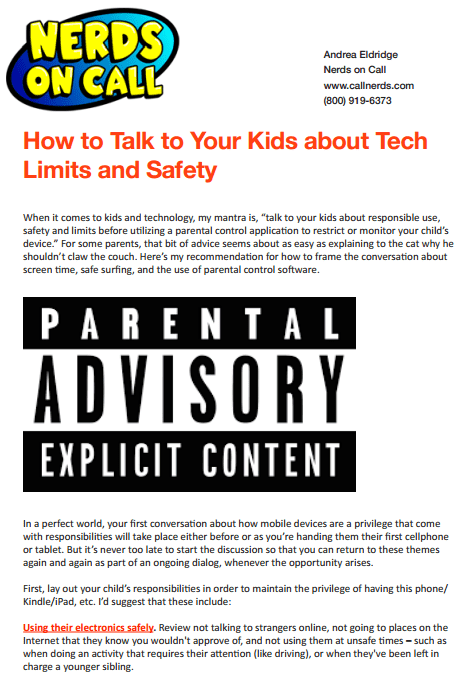This content has been archived. It may no longer be relevant
Ah, the good old days… when the only uncomfortable sex talk you had to have with your kid was about the birds and the bees. Not so for today’s parents, where technology has changed all the rules. Here’s why “sexting” should be a part of the conversation, and how to talk to your teen about staying safe.
First off, what is sexting? The term applies to sending or receiving sexually explicit messages, images, videos or content. They are typically via text, email, social media or through a cellphone app.
Before you dismiss the thought as something you’re little angel couldn’t possibly be involved in, note that recent studies put the number of teens that have sexted their boyfriend or girlfriend at over 70%. It’s so common, in fact, that sexting may be “new normal” of adolescent sexual behavior.
It’s not particularly surprising in our digital age that adolescents would use technology to explore their sexuality. While 77% of boys say that they use sexting to initiate sex, girls most often report that they’ve participated “as a joke,” or “to feel sexy.” More concerning:
61% of teens say they felt pressure to send a sext, particularly girls. Girls are asked to send a sext 68% more often than boys, but the shaming for them when the message or image is shared or sent out publicly is much harsher.
The good news is that no link has been found between sexting and high-risk behaviors like alcohol or drug use. There also isn’t a direct correlation between sexting and number of sexual partners. The bad news is that teens who sext ARE more likely to become sexually active in the time immediately following their sexting activity as sexting may be an indicator that teens are beginning to initiate and/or engage in sexualized relationships.
When it comes to sexting, there are several issues that you and your child should be aware of:
- Legal ramifications:
In some states, sending a “sext” by or to a minor could be prosecuted as a felony under child pornography laws. There are potential consequences for sending, receiving and keeping an image of a minor, as well as for sharing images received. Parents who are aware that their child is participating in sexting could also be held accountable.
While rare, there are notable cases where teens have been charged with sexual exploitation of a minor and threatened with having their name added to the sex offender registration list as a result of sexting activities:
Police in Fayetteville, North Carolina charged 17-year-old Cormega Copening with sexual exploitation of a minor (his girlfriend, who is the same age) because the couple exchanged nude photos of themselves during their relationship. Copening was benched from the football team, where he’d been a starting quarterback. His girlfriend also faced charges.
A 17-year-old Manassas City teenager faced charges of possession of child pornography and manufacturing of child pornography, both felonies, after he was accused of “sexting” a video of his erect penis to his girlfriend. The teen was arrested and taken to the county’s Juvenile Detention Center where, among other things, photos were taken of his genitals.
Many states have enacted laws that specifically relate to sexting, but California does not. This leaves under age sexting in California subject to child pornography laws.
- Social embarrassment:
It’s important that teens understand that there are permanent consequences to impulsive acts. Once you send a message, photo or video, it’s out of your control. The recipient could capture and share with others that you never intended to see it. Even if they don’t share it immediately, they could distribute images, videos, texts or emails in retaliation for a future wrong or bad breakup.
Bottom line: once you send something out electronically you can’t ever get it back.
The sharing of received sexting images and messages is more common than you may imagine: 17% of sexters report sharing messages with someone else.
- Peer pressure:
Many teens, especially girls, feel pressured to participate in sexting. More than half (51%) of teenage girls that have participated in sexting report that pressure from a guy caused them to send sext.
Parents need to be aware of the resources that teens are using to share sexts. Besides straight text and email, sexual images and messages are often exchanged through social media. This is concerning as images, files and messages are linked to their profile.
There are a number of smartphone apps that are used to send sexts. Apps like SnapChat and Cyber Dust give a false sense of security because messages and images sent through the forum after a short period time. Many people believe that this makes it impossible for the recipient to save or forward the image, but this is not the case. The recipient could capture the image before it is auto-erased, either through a third-party add-on app intended to override SnapChat’s restrictions on screen shots and image retention.
Apps such as Whisper and Yik Yak make the message’s original sender anonymous, making them another popular forum for the exchange of sext messages and images.
Look for these apps on your child’s device. While you’re at it, regularly investigate the apps on your child’s phone or mobile device to ensure that you are aware of the apps they’re using and for what purpose.
Look for acronyms and hashtags commonly used in texts & social media posts. Check out the list of commonly-used acronyms that may hint at sexting in the infographic on this page.
It’s imperative that parents include sexting in their sex education conversations, as well as in the context of Internet safety. It’s best not to focus on criminal consequences as most kids feel its exceedingly unlikely that they’d be prosecuted. If that’s the cornerstone of your “don’t do it” argument, teens may tune you out if they decide that legal consequences are a non-issue. Teens also tend to tune out alarmist parent advice.
How can you improve your chances of making an impression on your teen?
- Have the conversation as soon as possible.
The best time to talk about responsible use is when you hand your child a cell phone or mobile device. Introduce the topic with younger kids as part of a bigger “someone may pressure you to participate and you don’t have to” conversation. Assume your kids WILL someday get a sext, or be asked to engage in sexting.
- Focus on self-worth & reputation
More than a third of teens say they’ve had a sext that was meant for someone else shared with them. Ask your child to consider how they would feel if their message/photo/video got spread around the school. Every electronic communication they send could be shared or spread without their knowledge or intent so suggest that they only send messages or images that they would be ok with a friend’s parents, potential crush, or their favorite teacher seeing.
- Instead of sitting your teen down and presenting the dangers of the Internet, aim for an open conversation where you engage them and hear what they think. Talk early and talk often.
Parents should utilize parental control and monitoring software in order to be alerted to dangerous behavior, so long as it is used in an honest and upfront manner. Don’t just install software on the fly and then confront your teen about bad choices – that will damage your trust and relationship. Instead, integrate monitoring software into the larger discussion.
Monitoring with a program like “Teen Safe” (http://www.teensafe.com/) allows you to see (almost) all your child’s online activities. You can view texts, phone call logs, social media posts to sites like Instagram and Facebook. You can see activity in WhatsApp and Kik messages, as well as their Web Browsing history.
Just don’t monitor in secret. Try to establish trust with open communication, unless you think child is hiding dangerous activities in spite of your conversations.
For more information about teen tech safety, or to access the take home materials provided to Vintage High School parents and teachers detailing tips for talking to your kids about mobile device safety and responsibility, click here.

About The Author: Andrea Eldridge is CEO and co-founder of Nerds On Call, a computer repair company that specializes in on-site and online service for homes and businesses. Andrea is the writer of a weekly column, Nerd Chick Adventures in The Record Searchlight. She prepares TV segments for and appears regularly on CBS, CW and FOX on shows such as Good Day Sacramento, More Good Day Portland, and CBS 13 News, offering viewers technology and lifestyle tips. See Andrea in action at callnerds.com/andrea/.
Video Transcript
Mike: Hi! It’s back to school time and well, many families are stocking up on new books, pencils and uniforms. Others are sitting down to tackle difficult conversations to prepare their students for some of the more challenging aspects of social life in school. Today in the FOURX4, we are taking four minutes of 4:00 to help prepare families to discuss through the difficult topic of sexting with their children. And Keba, you’re joined now with a couple of guests.
Keba: Yeah, we do. We have Ryan Eldridge, one of our tech experts from Nerds on Call. Hi, Ryan.
Ryan: Hi.
Keba: We also have Caroline Knorr, Parenting Editor with Common Sense Media. Thank you both being here, such an important topic. Now guys, we throw out the word sext a lot, but some parents might not understand exactly what that means. What are talking about, Ryan, we talk about sexting?
Ryan: Well, you’re looking at sexually explicit material, photos, text, things like that. These are sent usually through email, text message or cell phone apps, things like that. That’s usually what texting is referred to.
Keba: And our kids are actually doing this? I mean, do we have any statistics? Kids are really doing this.
Ryan: Yeah, 39% of kids in our recent study said that yes, they sent some sort of sext text message and 48% had said that they have received some fort of sext type message.
Keba: So our kids are doing it. Why, Caroline? Why would they do something that seems so private to send a picture of yourself maybe personally. Why are our kids doing this?
Caroline: Well, they’re doing it partly because they can. A lot of these apps like Snapchat, Tinder, Instagram, make it really easy for kids to do it, which bypasses the texting app or the SMS texting on their phones and their parents don’t know. We are not living in a society with great celebrity role models around sexting. We see a lot of…
Keba: So we’re doing it.
Caroline: Yeah, like celebrities are sexting, so kids see it. We’re living in an always on type of culture and kids are really comfortable documenting their lives online.
Keba: But what are they risking by doing it that they might not realize?
Caroline: Right. You know kids have a hard time thinking through the consequences of their actions especially with apps that make it so instantaneous to share what they want to share. So they’re risking their reputation and in some cases, they’re risking prosecution. Yeah, the danger. This is actually a dangerous thing to do.
Ryan: A lot of kids, they rely on the technology Snapchat. It says that when you use the app, within a few seconds, it’s deleted anyway. But there was just recently a breach of a third-party application that hooked in to Snapchat. They got breached and all of those photos were taken and they were put up online. And like you mentioned, there are celebrities, if you take a look at what happened with the iCloud hack, there were all these celebrities that are taking those kinds of sexually explicit photos and they’re sharing them privately. But as soon as they got hacked, now they’re everywhere. And so stars like Jennifer Laurence, she’s never getting those back and her reputation has been marred because of it.
Keba: I read the blog because we have parents who say, “But I monitor. I have the password to all their accounts. I’m checking their text messages. Is that enough, Ryan?
Ryan: Not really. There are certain applications out there like Snapchat that delete messages as they’re sent. So you can’t just look back at their history, you can’t just look back at their text messages and their emails and see what they’re doing. Not to mention, they can also just use someone else’s phone to send this information.
Caroline: Or they can just create another account. It’s really easy to do it without parents knowing. So Common Sense Media, we really say it’s essential to talk to your kids about good habits and responsible behavior.
Keba: So you’re saying they have one account that mom knows. “But here is my password of this account, mom, but really I got a couple other on the side.”
Ryan: Yeah, that’s not unusual at all to see that. To have multiple accounts, that way they can hide their activities, exactly.
Caroline: At Common Sense Media, we say like it’s not the technology that makes kids bad, it’s really the parents responsibility to talk to kids about using the technology responsibly and respectfully.
Keba: Let’s go through some of that, you have some tips for us. What can parents do? We’re starting school now, new friends, maybe we’re in the eight grade now. What do you think?
Caroline: Yeah, we say you’ve got to have the sext talk. You have to talk to your kids about the risks, the dangers and the importance of not sharing something. If someone says like, “Oh, send me a pic,” that person does not have your best interest at heart. So we say that’s not a friend.
Keba: So you say accept reality, ask questions.
Caroline: You need to accept that your kids are on this. They’re digital natives. They’re very comfortable sharing their lives. So you have to accept that first. Don’t try and shame them or judge them or say, “I’m going to cut it all off.” Because as mentioned, they can do it themselves. We have to just talk them through it. We have to guide them through it. We have to offer good role model, good digital citizenship ourselves.
Keba: What about explaining the risk? If you do this, Johnny, this is what could happen. Or Serah.
Ryan: And 51% of females in schools are saying that they’ve been pressured by boys just to do these kinds of messages. And so they get into a social group where they’re getting pressure, not only from the boys to be cool and send out this thing, but also their friends are doing it. And if they saw someone else in the household doing it or sending sexually explicit messages, they might think it’s okay and that’s normal. Well, they don’t think about the consequences of these stuff living online forever.
Keba: A few more tips, stay current, know what’s out there, know the latest stuff.
Caroline: Exactly, yes. Have your kids share their social media with you. You don’t have to follow them, you don’t have to friend them, but have them share what they’re doing on there. Share yours with them so they can see what you’re doing. So that they can see like this is part of our life, it’s fun. It’s also just really important to make sure that you are current with the programs that they’re using. Take a look at competence media reviews, read the reviews of Snapchat. What are the risks and the pros and cons?
Keba: Quickly, Ryan, before we’re out of time, you feel you shouldn’t monitor in secret.
Ryan: Yeah. If you monitor in secret, you’re just going to drive it underground. Listen to Caroline, it said in her points. You don’t want to do that. If you drive it underground, they’re just going to go to their friends or they’re going to get another phone that they’re going to use and you’re not going to know about it. There are ways to monitor with technology.
Keba: Yeah, at teensafe.com. Tell me about that quickly.
Ryan: Well, teensafe.com will monitor everything they’re doing on their phone, from their text messages to their Snapchat, to their kick accounts, to all of that stuff. And so you can see it and monitor it. But if you do it in secret and then they find out, that’s when it’s going to go bad. So always have the conversation first and say, “Hey, these are the things that we don’t want you to do. I’m going to be watching, just in case. And if you ever feel uncomfortable, let’s talk about it.”
Keba: Okay, all right. Ryan, editor with the Know Zone Call, Caroline Knorr with Common Sense Media, great conversation. Thank you both.
Ryan: You’re welcome.
Video Transcript
Ken: Hi. Are we back?
Ryan: I think we’re back.
Ken: Welcome back to Good Day. Hanging out, once again, with our good friends from Nerd on Call. Ryan is here. Last time we were talking about myths with young kids on the screens. Now, we’re talking about something a lot more serious, with teenagers and this whole discussion you’ve got to have about mature topics.
Ryan: Yeah. You know, when a kid gets a cellphone and they start messing around with it, they do all kinds of crazy things and they don’t understand that there are real world consequences to some of the things they do online. They don’t know it’s going to last forever. So, we’re going to talk about sexting. Everybody’s kind of heard about it but you even asked me kind of what is it?
So, it’s any time you send sexually explicit emails, content, videos or pictures over text, chat or using an app on a cellphone. That’s what a sext is. Now, here’s the most alarming fact. 70% of teens have sent or received a sext. So, this is kind of the new normal. This is just what kids do these days and so, we can’t just ignore it and go, “My kid’s not doing that.” Or, “It’s just the kids that are doing a high risk behaviors. They are the only ones doing it.” No, they’re all kind of doing it at this point and so, it’s something that we need to talk to our kids about. For boys, 77% of the time that they send a sext, it’s because they’re trying to initiate sex.
Ken: Yes.
Ryan: For girls, though, they’re doing it often as a joke or they’re doing it because they want to feel sexy.
Ken: Okay.
Ryan: They’re also getting a lot of pressure. Most girls are getting constant pressure from their friends, as well as boys, to send sexts. 68% more often, boys are trying to get girls to send a sext and the problem is that the girls are the ones that get shamed when those sexts get out.
Ken: When they do it. Yeah. Exactly.
Ryan; And so, it’s terrible all around. One of the things we asked, “Is sexting dangerous? Is this going to lead to high risk behavior?” And there’s no link to alcohol or drug use or anything like that, but there is a link to more sexual activity. If they’re sexting, they’re more likely to be sexually active.
There is some consequences to this, real legal consequences. Sending a sext or even receiving a sext can be considered child pornography. So, possessing it can be. This isn’t something that most teens are concerned about. They’re thinking it’s one in a million. All my friends are doing it anyway. It’s not like the cops are going to get my phone. But what if they do? It’s just in case. There was just a story about a kid in Montana who spent time in jail for sending a sext to a 17-year old girl when he was 19. So, it’s kind of dangerous.
If we get down to 40% of teens who have sent a sext have had some kind of sexual abuse or sexual bullying because of the sext. Also, teens, what they’re using is they’re not just using the normal apps that we’re used to, like Facebook, but they’re using things like Whatsapp or temporary apps like Snapchat, Slingshot or Line. These are designed that, when you send the sext or the picture, that it will delete it but the problem is, you just take out another phone, boom! You get a screen grab of that and now you can send it everywhere. So, they’re not safe but a lot of teens think they’re.
But they also use anonymous chatting sources to send the stuff and so, their name’s not necessarily on it and so who knows who they’re chatting with. Sometimes, they’re chatting with other friends but sometimes they could be chatting with other people across state lines, saying all kinds of crazy things.
This is about acronyms. We all get acronyms. These are some of the main ones that people are using, not safe for work, direct message me, age sex and location. So, these are some of the terms that kids are using for short and hiding it from their parents, but there’s so many more. If you go online and just Google it, you’ll see it.
Ken: We’re running out of time. What do you got? Last thing.
Ryan: Lastly, what do you do about it? You want to have a conversation with your kids. When you hand them a cellphone, have a conversation about appropriate use. Talk to them about their reputation and that they can’t get it back once it gets damaged. You can use apps like Teensafe. Teensafe you can get on iPhone or Android and it will monitor their activity online. They’ll monitor also those anonymous apps, so they’ll be able to track all that stuff but don’t do it anonymously. Don’t just track their activity without talking to them. Talk to them first, because if they find out your tracking them without knowing it, they’re just going to go underground or get another phone or use somebody else’s stuff.
Ken: Go deeper out there. Exactly. Ryan, always good to get the information from you. Julissa, our babies are growing up too fast.
Julissa: I know. We’ve got to slow down. We’ve got to stop the clock. Stop the clock! Yes. Alright. Thanks, Ken.






